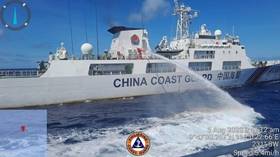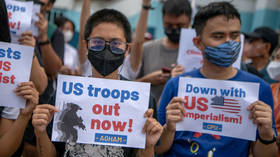US Navy vows to counter China’s ‘aggressive behavior’ – media
An American vice admiral has reportedly called for pushing back against Beijing in the South China Sea
The commander of the US Navy’s largest forward-deployed fleet has reportedly responded to a recent confrontation between Chinese and Philippine ships in the South China Sea by pledging to push back against the alleged aggression of Beijing’s forces in the region.
Vice Admiral Karl Thomas, commander of the US Seventh Fleet, on Sunday assured the Philippines of Washington’s backing in countering China’s “aggressive behavior,” Reuters reported. “My forces are out here for a reason,” he said, citing the “shared challenges” faced by the US and its Philippine ally.
Thomas made his comments about three weeks after an incident in which the Chinese Coast Guard deployed water cannon against Philippine vessels that were trying to resupply a warship that Manila had intentionally grounded on a contested South China Sea shoal in 1999. The resupply mission was finally completed on Tuesday, delivering food and other goods to troops stationed on the World War II-era ‘Sierra Madre’ transport ship.
“You have to challenge people, I would say, operating in a grey zone,” Thomas told Reuters. “When they’re taking a little bit more and more and pushing you, you’ve got to push back. You have to sail and operate.” He added, “There’s really no better example of aggressive behavior than the activity on 5 August on the shoal.”
Thomas held talks with Vice Admiral Alberto Carlos, who heads the Philippine Western Command overseeing Manila’s South China Sea interests. “We certainly shared challenges,” the US commander said. “So, I wanted to better understand how he views the operations that he’s responsible for, and I want to make sure that he understood what I had available.”
The US Seventh Fleet, based in Japan, covers an area of operations spanning more than 124 million square kilometers in the Western Pacific, from the International Date Line to the India-Pakistan border. It boasts about 60 ships and submarines, as well as 140 aircraft and about 20,000 sailors. Its operational zone encompasses half of the world’s population and the five largest military powers outside the US, including Russia and China.
Tensions between the Philippines and China have escalated since Ferdinand Marcos Jr. took office as president in Manila last year. Marcos has forged closer defense ties with the US and asserted his country’s territorial claims in the South China Sea. For instance, the Philippines placed navigational buoys around the Spratly Islands in May, staking its claim to an area over which Beijing claims sovereignty.
Chinese officials have warned that strengthening military cooperation with the US will tie the Philippines “to the chariot of geopolitical strife,” jeopardizing the country’s security. Beijing and Washington have repeatedly accused each other of military provocations in the South China Sea.







Comments are closed.